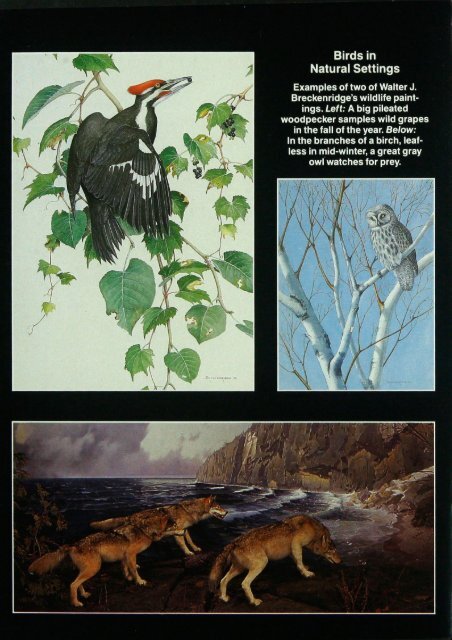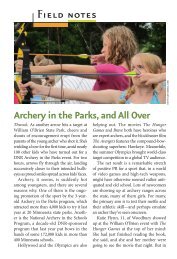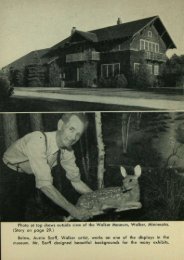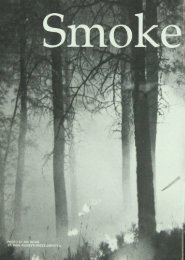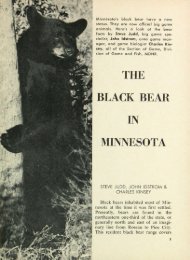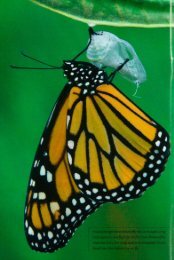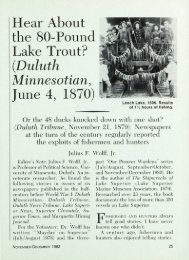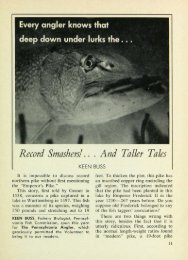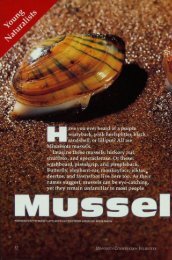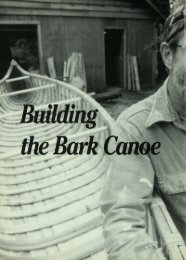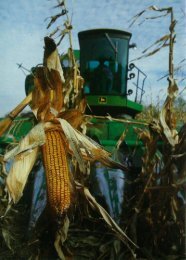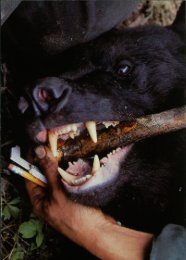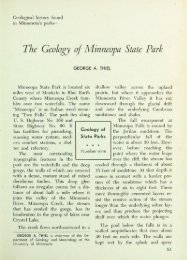218 Bell Museums Creator of Wildlife Dioramas - webapps8
218 Bell Museums Creator of Wildlife Dioramas - webapps8
218 Bell Museums Creator of Wildlife Dioramas - webapps8
You also want an ePaper? Increase the reach of your titles
YUMPU automatically turns print PDFs into web optimized ePapers that Google loves.
Birds in<br />
Natural Settings<br />
Examples <strong>of</strong> two <strong>of</strong> Walter J.<br />
Breckenridge's wildlife paintings.<br />
Left: A big pileated<br />
woodpecker samples wild grapes<br />
in the fall <strong>of</strong> the year. Below:<br />
In the branches <strong>of</strong> a birch, leafless<br />
in mid-winter, a great gray<br />
owl watches for prey.
For 60 years, Walter J. Breckenridge created<br />
exhibits to stimulate viewers' curiosity about<br />
the natural world. Naturalist, painter, taxidermist,<br />
he saw himself primarily as an educator<br />
4CT NOW ASK: What is our educa-<br />
X tional system doing to encourage<br />
personal, amateur scholarship in<br />
the natural history field? Does the<br />
educated citizen know he is only a cog<br />
in an ecological mechanism? That if<br />
he will work with that mechanism his<br />
mental health and his material wealth<br />
can expand indefinitely? But that if<br />
he refuses to work with it, it will ultimately<br />
grind him to dust? If education<br />
does not teach us these things,<br />
then what is education for?<br />
Author-conservationist Aldo Leopold<br />
posed these questions nearly 40<br />
years ago in A Sand County Almanac<br />
<strong>Bell</strong><br />
Museum's<br />
<strong>Creator</strong> <strong>of</strong><br />
<strong>Wildlife</strong><br />
<strong>Dioramas</strong><br />
Don Luce and Gayle Crampton<br />
Left: Prepared by Walter J. Breckenridge in 1940, a trio <strong>of</strong><br />
timber wolves scent a deer on the North Shore <strong>of</strong> Lake Superior<br />
near Palisade Head. Diorama is on display at <strong>Bell</strong> Museum.<br />
to help spark the environmental<br />
movement. Several decades earlier,<br />
Leopold and a few other scientists and<br />
teachers had already foreseen the<br />
negative effects <strong>of</strong> a growing population<br />
and expanding industry on the<br />
environment. By promoting the<br />
teaching <strong>of</strong> natural history, they laid<br />
the foundation for a greater understanding<br />
<strong>of</strong> our natural surroundings.<br />
One <strong>of</strong> those teachers was Walter<br />
J. Breckenridge, past director <strong>of</strong> the<br />
James Ford <strong>Bell</strong> Museum <strong>of</strong> Natural<br />
History on the University <strong>of</strong> Minnesota<br />
campus, Minneapolis. As a naturalist,<br />
ecologist, photographer, and<br />
37
<strong>Creator</strong> <strong>of</strong> <strong>Dioramas</strong><br />
illustrator, he spent much <strong>of</strong> his career<br />
designing and creating educational<br />
experiences to help us become<br />
familiar with the natural world.<br />
Anyone who has hiked trails in our<br />
state parks lias been exposed to<br />
Breckenridges work. Many children<br />
saw their first moose or bear in a<br />
Breckenridge diorama at <strong>Bell</strong> Museum.<br />
In the museum s Touch and See<br />
Room, they stroked a wolfs pelt or<br />
touched the points on a rack <strong>of</strong> antlers.<br />
These exhibits expressed the<br />
spirit and philosophy <strong>of</strong> Walt<br />
Breckenridge.<br />
But this sophisticated level <strong>of</strong> environmental<br />
education is a relatively<br />
recent phenomenon. During Breckenridges<br />
school years, little or nothing<br />
was taught about natural history.<br />
"When I was a boy," he recalled,<br />
"no teacher ever mentioned anything<br />
that was out-<strong>of</strong>-doors. Reading, writing,<br />
and arithmetic were all they<br />
thought about. I got acquainted with<br />
outdoor things by playing hooky from<br />
school and going down to play along<br />
the creek."<br />
At the University <strong>of</strong> Iowa, Breckenridge<br />
studied zoology. Graduating<br />
in 1926, he came to UM as a preparator<br />
and taxidermist.<br />
The museum, then housed in the<br />
Zoology Building, was headed by the<br />
well-known ornithologist T. S. Roberts.<br />
Roberts had left a successful<br />
medical career 10 years earlier to<br />
pursue his interest in natural history<br />
— compiling ornithological observations,<br />
experimenting with bird photographs,<br />
and directing the construc-<br />
38<br />
tion <strong>of</strong> dioramas. Breckenridge was<br />
just the person Roberts needed.<br />
Grass Machine. The young preparator's<br />
first project was the Pipestone<br />
Prairie diorama. The prairie<br />
scene required more than 100,000<br />
blades <strong>of</strong> artificial grass. The same<br />
exhibit contained a buffalo-berry bush<br />
for which 9,000 leaves were cut with<br />
stencils and assembled by hand. Ordinarily,<br />
plants for dioramas were<br />
carefully hand-sculpted from colored<br />
waxes and molds.<br />
Faced with this daunting task,<br />
Breckenridge set about devising a new<br />
method <strong>of</strong> creating a prairie. He built<br />
a machine operated by a foot pedal<br />
which produced 2,500 blades <strong>of</strong> grass<br />
in a day. Preparators mounted each<br />
blade in a papier-mache base among<br />
dead grass to produce the lifelike<br />
plants in the prairie exhibit.<br />
Breckenridge then constructed a<br />
series <strong>of</strong> portable dioramas, one <strong>of</strong> the<br />
museum's earliest efforts to extend<br />
education beyond the walls <strong>of</strong> the<br />
University. The cases, two feet square<br />
and 10 inches deep, included scenes<br />
<strong>of</strong> birds and other animals in small<br />
slices <strong>of</strong> natural habitat.<br />
These portable dioramas circulated<br />
among schools — teachers used<br />
them in natural history lessons. In<br />
1927, 15 schools participated in the<br />
program; by the next year the number<br />
had doubled. Eventually more<br />
than 150 cases were built. Many are<br />
still used today.<br />
When the museum's new home, the<br />
<strong>Bell</strong> Museum, was completed in 1940,<br />
Walter J. Breckenridge in workshop at <strong>Bell</strong> Museum, Minneapolis,<br />
with animals prepared for exhibit — cormorants on rocks in 1942<br />
(top, right), and wolves in 1941 (bottom, right).
<strong>Creator</strong> <strong>of</strong> <strong>Dioramas</strong><br />
Breckenridge supervised moving the<br />
Pipestone Prairie and six other large<br />
exhibits — no small task since the exhibits<br />
could not be moved as units. A<br />
herd <strong>of</strong> caribou in a bog, a beaver dam<br />
and lodge, a cattail marsh containing<br />
dozens <strong>of</strong> birds and nests had to be<br />
carefully taken apart, moved down the<br />
street, then reassembled.<br />
In the new museum, Breckenridge<br />
planned dioramas featuring<br />
wolves, snow geese, sandhill cranes,<br />
and more. To design and paint the<br />
background panoramas, Francis Lee<br />
Jaques came from New York where<br />
he had worked as an artist for the<br />
American Museum <strong>of</strong> Natural History.<br />
Later, John Jarosz, a remarkably<br />
talented taxidermist, joined the team.<br />
Together they created a series <strong>of</strong> exhibits<br />
for the museum that are still<br />
considered among the finest in the<br />
country.<br />
Minnesota Habitats. Breckenridge<br />
and Jaques wanted to design a<br />
series <strong>of</strong> exhibits featuring species,<br />
seasons, and habitats appropriate for<br />
Minnesota. Breckenridge said:<br />
"Our groups were planned as a trip<br />
through the various habitats in Minnesota.<br />
As you walked through the<br />
exhibit halls, you traveled all around<br />
the state, from the southeastern<br />
hardwoods, up along the Mississippi,<br />
out into the prairies in the west, and<br />
back through the pine and spruce<br />
woods in the north."<br />
In the new exhibits, Breckenridge<br />
and Jaques strove for biological accuracy<br />
and educational value — the<br />
dioramas were not to be glorified trophy<br />
cases. Each exhibit featured ecological<br />
stories that stimulated a visitor's<br />
curiosity. Snow geese fly at the<br />
peak <strong>of</strong> migration; sandhill cranes leap<br />
in a courtship dance; songbirds mob<br />
a great gray owl. Even the rocks, soil,<br />
and vegetation are realistic. The result:<br />
a set <strong>of</strong> exhibits <strong>of</strong> outstanding<br />
beauty, realism, and authenticity.<br />
Breckenridge also pioneered in<br />
nature films. At first, he was restricted<br />
to heavy, hand-cranked cameras.<br />
Nevertheless, he collected valuable<br />
footage. On one 1928 trip, he<br />
filmed nesting cranes, a ruffed grouse<br />
drumming, prairie chickens on their<br />
booming grounds, and the first sequences<br />
filmed <strong>of</strong> strutting sharptailed<br />
grouse.<br />
For years, his films were shown<br />
during the museum's popular Sunday<br />
afternoon programs. Later, Breckenridge<br />
produced films to accompany<br />
his Audubon Society lectures<br />
throughout the country. Topics ranged<br />
from the territorial behavior <strong>of</strong> birds<br />
to current conservation issues. His<br />
nature films were among the first to<br />
be aired on public television.<br />
40 Above: <strong>Wildlife</strong> artist Francis Lee Jaques painting background<br />
for wolf group diorama, June 1940. Right: Breckenridge filming<br />
winter wildlife at Lake 4, Cook County, March 1938.
<strong>Creator</strong> <strong>of</strong> <strong>Dioramas</strong><br />
Some films he made during research<br />
or collecting trips to northern<br />
Canada and the Arctic. He was one<br />
<strong>of</strong> the first non-Eskimos since the<br />
1800s to travel on the Back River in<br />
Canada's Northwest Territory.<br />
Park Programs. In 1947, soon after<br />
becoming the museum's director,<br />
Breckenridge saw an opportunity to<br />
expand the education program to state<br />
parks. At the time, the Department<br />
<strong>of</strong> Conservation was buying land while<br />
prices were low; no funds were available<br />
for nature programs.<br />
"We figured people visiting the<br />
parks were good subjects," Breckenridge<br />
said, "because by being there<br />
they showed an interest in nature, but<br />
probably didn't know much about it."<br />
As a result, the State Park Interpretive<br />
Program was created.<br />
Breckenridge sent museum employee<br />
Donald Lewis to Itasca State<br />
Park for several summers. Lewis designed<br />
nature trails, led hiking groups,<br />
and lectured 011 the park s flora and<br />
fauna.<br />
The program grew rapidly. The first<br />
year, 4,227 visitors to Itasca took part<br />
in the program. By 1955, the figure<br />
had grown to 15,917. Naturalists<br />
joined the staffs at Gooseberry Falls,<br />
Lake Shetek, and Whitewater state<br />
parks. For several years, <strong>Bell</strong> Museum<br />
continued to pay part <strong>of</strong> their<br />
salaries. As the interpretive program<br />
grew, more parks began to participate.<br />
Today, Breckenridge's interpretive<br />
programs have expanded to nearly<br />
every state park in Minnesota.<br />
In recent photo, Breckenridge holds skin<br />
<strong>of</strong> wood duck to depict bird accurately.<br />
Since his retirement as museum<br />
director in 1969, Breckenridge has<br />
devoted his days to painting. His work<br />
has appeared in such prestigious exhibitions<br />
as "Birds in Art at the<br />
Woodson Museum in Wisconsin and<br />
at the <strong>Wildlife</strong> Heritage Art Show in<br />
Minneapolis. In recent years, he has<br />
traveled to Africa, South America, and<br />
New Zealand in search <strong>of</strong> new subject<br />
material. The artist's studio is in<br />
his home in Brooklyn Park.<br />
His artistic career started a halfcentury<br />
ago. In the early 1930s, he<br />
painted the shorebirds and woodpeckers<br />
for T. S. Roberts' The Birds<br />
<strong>of</strong> Minnesota and illustrated maga-<br />
42 THE MINNESOTA VOLUNTEER
Walter J. Breckenridge:<br />
A Life in Natural History<br />
An exhibition displaying photographs, artifacts,<br />
and paintings from Dr. Breckenridge's<br />
60-year career as an educator and<br />
interpreter <strong>of</strong> natural history now appears<br />
at the James Ford <strong>Bell</strong> Museum <strong>of</strong> Natural<br />
History, 10 Church Street SE, on the Minneapolis<br />
campus <strong>of</strong> the University <strong>of</strong> Minnesota.<br />
The exhibition will remain open until<br />
March 15,1987.<br />
-fr 1k ft<br />
zine articles on natural history with<br />
drawings and paintings.<br />
These days it's hard to coax him<br />
away from his easel. But promoter <strong>of</strong><br />
natural history that he is, Breckenridge,<br />
at age 83, still delivers lectures,<br />
writes articles, and serves on<br />
committees <strong>of</strong> The Nature Conservancy<br />
and Audubon Society.<br />
His goal, as always: to encourage<br />
interest and scholarship in the fascinating<br />
study <strong>of</strong> natural history. •<br />
Dun Luce is Assistant Curator <strong>of</strong> Exhibits,<br />
James Ford <strong>Bell</strong> Museum <strong>of</strong><br />
Natural History, Minneapolis. With<br />
Chris Brooks, he wrote about wildlife<br />
painter Francis Lee Jaques in<br />
"Master Painter <strong>of</strong> the North Country"<br />
in the November-December 1984<br />
Volunteer. Gayle Crampton is a special<br />
research assistant at the <strong>Bell</strong><br />
Museum.<br />
What Northeastern Minnesota Woodland Owners Value Most<br />
"WANTED: 10 to 49 acres wooded upland with paved road access, lake or stream<br />
access, excellent fishing, abundant wildlife, pine or oak trees. A University <strong>of</strong><br />
Minnesota study found that these property characteristics were most highly prized<br />
by buyers <strong>of</strong> woodland in 13 northeastern Minnesota counties.<br />
— University <strong>of</strong> Minnesota, Minnesota Extension Service<br />
Promise and Pro<strong>of</strong> <strong>of</strong> Changing Season<br />
"CHANGE has already set in. Slight change. That's one thing you must say for<br />
January: Its daylight hours increase rather than diminish . . . sunset now comes<br />
later. By the end <strong>of</strong> January there will be about three-quarters <strong>of</strong> an hour more<br />
daylight.<br />
"Thus do winters days change, even as molasses-slow January flows past. Already,<br />
if we watch the sunset closely, we can glimpse the end <strong>of</strong> winter. On a<br />
brittle cold day that ice-green band <strong>of</strong> light may mark the horizon . but it<br />
comes later than it did a week ago. It's still a matter <strong>of</strong> minutes, but the change<br />
has begun. That's the promise, and that's the pro<strong>of</strong>."<br />
— Editorial in The New York Times<br />
JANUARY-FEBRUARY 1987<br />
43


